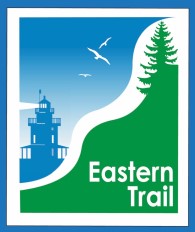By ETA President Bob Hamblen
[Note: This article appeared in the Late Fall 2013 Newsletter. The full newsletter can be viewed in this pdf document]
In the next to last week of October I hit the jackpot. No trip to Foxwoods, or Oxford for that matter, involved. And I haven’t bought a Powerball ticket … uh, ever. Instead, I had the opportunity to chat about the Eastern Trail at three separate events, and this wasn’t a case of the ETA begging for a chance to set up a table so we could try to sell folks on the Trail.
Nope, the ETA was actually invited to attend three meetings and participate in panel discussions; these groups really wanted to hear about the Trail, even though, per a show of hands at the latter two events, the majority of attendees were already familiar with the ET.
On October 22 the second quarterly meeting of the York County Bicycle and Pedestrian Committee convened, the brainchild of the Bicycle Coalition of Maine and Southern Maine Planning and Development Commission (formerly Southern Maine Regional Planning Commission). There’s a lot happening on the bike and ped scene, and those who created the committee recognize the value of sharing experiences. So they invited three of us to offer input on the state of trails: Alix Hopkins, former executive director of Portland Trails, author and community activist, related progress to date on the Biddeford River Walk, including a planned pedestrian bridge that would span the Saco River in the Biddeford and Saco Historic Mills District. MaryAnn Conroy has just assumed the director’s role at the Kennebunk public works department, and is an ET veteran of sorts via her previous employment with the Town of Old Orchard Beach. The three of us and all attendees compared notes about funding.
The YCBPC meets quarterly, next time in Sanford to hear about that city’s ambitious trails plan. All welcome; contact Myranda McGowan (mmcgowan@smrpc.org) for more information.
Next afternoon Sustain Southern Maine hosted an information-sharing session on growing trail accessibility. Professor Jack Kartez explained the forum this way: “There is widespread consensus among both health and development experts that ready access to non-motorized trails linking people to the landscape they live in provides benefits and amenities needed for a successful area-wide economy attractive to a wide variety of people.”
This gathering, the seventh in a series that SSM hosts on topics that have included climate change, housing, energy, and locally grown foods, Trails and a Livable Southern Maine, included Jim Tasse of the BCM who spoke on the growing popularity of single-track bike trails, Steve Engle of the Maine Center for Community GIS, who maintains the Maine Trail Finder website, and Matt Craig of the Casco Bay Estuary Partnership. Jack and Kara Wooldrik, Executive Director of Portland Trails, hosted the panel discussion which examined how regional trails such as the ET are spawning local trails, creating a network of sustainable transportation and fitness options.
The third event of the week convened on the Eastern Trail in Kennebunk. Bob Bowker, ET vice president and Tim Cote, the project engineer for the Biddeford to Kennebunk section of the Trail, hosted members of the Maine chapter of the American Society of Civil Engineers for a tour on bike and foot. The group later convened for its dinner meeting in Scarborough, and listened to trail talk from Tim and co-HNTB employee Greg Blake, Nancy Grant of the BCM, Dan Stewart of Maine DOT, and me. Topics included funding options for trails (limited), current challenges to extending trails in Maine, and MDOT’s role.
While many of us look to our ‘leaders’ in Augusta and Washington and can only shake our heads, you can take encouragement from the fact that lots of people out there ‘get it,’ and are actively learning from and sharing the best of what is happening locally and regionally. We’re pleased that the ET is very much in the mix.
Share this Story:












0 comments
Write a comment